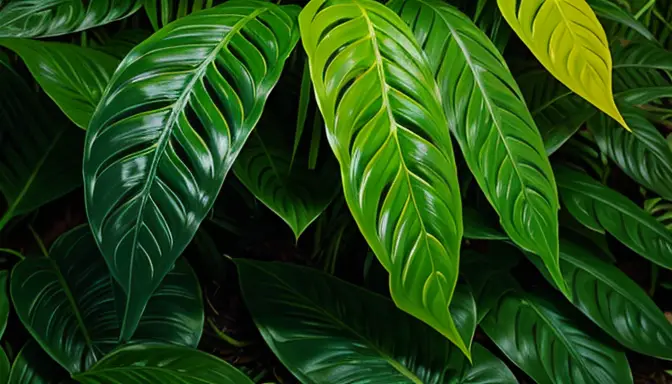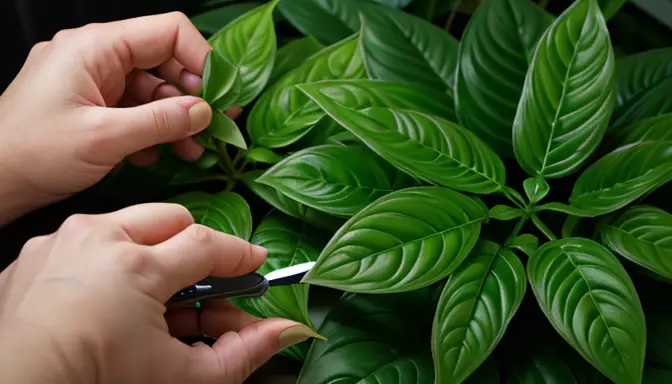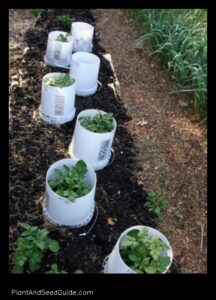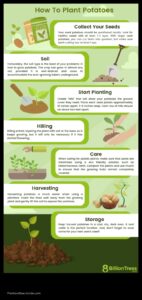Prayer plants, with their mesmerizing foliage, can bring a touch of nature’s artistry into your living space.
Let’s delve into the enigmatic world of prayer plants and unravel the secrets behind their changing colors.However, when those vibrant leaves start to turn yellow, it’s like a botanical mystery unfolding before your eyes..
Ah, the woes of overwatering – a common plight for many plant parents. Those yellow leaves whisper tales of roots drowning in despair. Find the balance, let the soil breathe, and watch your prayer plants dance with joy once more under the gentle rain of hydration.
Light, the silent painter of leaf colors, holds the brush to your plant’s canvas. Too much sun, and the leaves may blush with sunburn; too little, and they fade into a pale imitation of their true selves. Find the sweet spot, where sunlight kisses the leaves just right, creating a masterpiece of green hues.
A plant’s diet matters more than you think. Just like us, prayer plants crave their essential nutrients to thrive. Without the right balance, those yellow flags start waving. Feed your botanical buddies well, and watch them flourish in all their green glory.
Nature’s party crashers, the pests, can turn your plant haven into a battleground. Those tiny invaders stress out your prayer plants, leaving behind a trail of yellowed leaves. Show them the door with natural defenses and keep your green sanctuary pest-free.
Extreme temperatures, like moody weather gods, can wreak havoc on your plant’s well-being. Find the Goldilocks zone, where the temperature is just right, and watch your prayer plants thrive in a climate that’s not too hot, not too cold, but just perfect.
Beneath the surface, a silent menace lurks, threatening your plant from within. Root rot, the sneaky culprit behind yellowing leaves, can sabotage your botanical bliss. Detect it early, treat it with care, and save your plant from a rooty disaster.
Humidity, the unsung hero of plant care, plays a vital role in your prayer plant’s happiness. Without enough moisture in the air, those leaves may droop and turn yellow in protest. Create a spa-like atmosphere for your plants, where humidity reigns supreme, and watch them thrive in lush greenery.
A trim here, a snip there – pruning is an art form that promotes leafy wellness. Say goodbye to those yellowed, tired leaves, and make room for fresh growth to flourish. With each careful cut, you sculpt your prayer plant into a masterpiece of green vitality.
The foundation of plant health lies in the soil beneath their roots. Choose wisely, for the wrong soil mix can spell disaster in shades of yellow. Give your prayer plants a solid ground to stand on, rich in nutrients and free of suffocating compaction.
Stress, the silent killer of plant vibrancy, can manifest in those yellowing leaves. Be the zen gardener your plants need, providing a calming environment free of tension. Watch as your prayer plants breathe a sigh of relief, their leaves regaining their natural green glow in a stress-free oasis.
1. Overwatering Woes ️
Prayer plants, with their mesmerizing foliage, can bring a touch of nature’s artistry into your living space. However, when those leaves start turning yellow, it’s like a botanical mystery unfolding before your eyes. Let’s delve into the enigma of yellowing leaves in prayer plants and unveil the secrets to keeping them lush and vibrant.
Picture this: your prayer plant floating in a tiny green boat, paddling through a sea of waterlogged soil.
Find the perfect balance between hydration and suffocation to rescue your plant pals from this aquatic tragedy.Excessive watering can drown your green beauties in despair, turning their leaves a sorrowful shade of yellow..
Paragraph 1: As the rain pours outside, it’s tempting to shower your prayer plant with love and water. But remember, too much of a good thing can lead to disaster. Those yellow leaves are like nature’s warning signs, telling you to ease up on the watering can. Let the soil breathe, let the roots dance in moderation, and watch as your prayer plant transforms from a waterlogged mess to a thriving masterpiece.
Paragraph 2: Imagine your prayer plant as a drama queen, gasping for air as it drowns in a puddle of overindulgence. Don’t let your green diva suffer in silence! Give it the gift of balanced hydration, and witness the magic of green leaves unfurling in gratitude. Say goodbye to yellowing woes and hello to a flourishing botanical companion that will make your space bloom with life.
2. Light Levels and Leaf Color
Prayer plants are known for their vibrant foliage, but yellowing leaves can be a cause for concern. Explore the common reasons behind this issue and how to address it to keep your plants thriving.
When it comes to the radiant world of prayer plants, light plays a crucial role in determining their leaf color. Basking in the right amount of sunshine can make these plants shine like little botanical stars. However, too much or too little light can lead to a disco dance of yellowing leaves that no plant parent wants to witness. Remember, plants are like us, they need their daily dose of sunshine therapy but without the risk of a leafy sunburn.
Let’s shed some light on this leafy matter.
Think of it as a delicate solar ballet where the plants pirouette in the perfect amount of sunlight. Keep them away from dark alleys or blinding spots to ensure they flaunt their colors with pride. Remember, balance is the key to a leafy disco inferno that doesn’t end in a yellowing catastrophe.Providing adequate light levels is key to maintaining the vibrant patterns of your prayer plants..

3. Nutrient Deficiencies and Yellowing
Prayer plants are a delightful addition to any botanical collection, but when their leaves start turning yellow, it’s like a red flag in a field of green. Let’s delve into the intriguing world of nutrient deficiencies and how they can cause this colorful conundrum.
Nutrient deficiencies are like a plant’s version of a balanced diet – without it, things can get a bit yellow around the edges. Imagine your prayer plant whispering, “I need my vitamins, please!” Let’s explore the essential nutrients these plants crave and how to ensure they get their daily greens.
When your prayer plant starts sporting yellow leaves, it’s like a cry for help in the language of foliage.
Without these essentials, your plant might as well be on a leafy strike, protesting its lack of proper nutrition. Remember, a well-fed plant is a happy plant!Magnesium, iron, and nitrogen are the Ps in the nutrient world for these green beauties..
In the nutrient game, it’s all about balance and variety. Just like us humans, plants need a diverse diet to thrive. So, mix up your fertilizer regimen and give your prayer plant a buffet of nutrients to choose from. Think of it as a plant spa day – pamper those leaves with the nutrients they deserve, and you’ll be rewarded with a lush, green display that will make your botanical buddies jealous.
4. Pests: The Uninvited Guests
Prayer plants, with their mesmerizing patterns, can bring a touch of nature’s artwork into your living space. However, the sight of yellow leaves on these botanical beauties can be quite distressing. Let’s delve into the world of prayer plants and unravel the mysteries behind their yellowing foliage.
In the lush realm of prayer plants, pests can sneak in like party crashers at a botanical ball.
To combat these tiny troublemakers, vigilance is key. Regularly inspect the foliage for any signs of infestation, such as webbing or tiny creepy-crawlies. When dealing with pests, remember that prevention is always better than intervention. Implementing natural remedies like neem oil or introducing beneficial insects can help keep these unwanted visitors at bay. Remember, in the battle against pests, a little strategy goes a long way in preserving the vibrancy of your prayer plants.These uninvited guests, such as aphids and spider mites, can wreak havoc on your precious green companions, causing their leaves to turn a sorrowful shade of yellow..
Stay tuned for more insights on nurturing your prayer plants and banishing the yellow leaf blues!
5. Temperature Troubles and Leaf Health ️
Prayer plants are known for their vibrant foliage, but yellowing leaves can be a cause for concern. Explore the common reasons behind this issue and how to address it to keep your plants thriving.
When it comes to the well-being of prayer plants, temperature plays a crucial role in leaf health. Extreme temperatures can send your botanical buddies into a frenzy, causing those once lively leaves to turn a sad shade of yellow. To avoid this botanical drama, it’s essential to understand the optimal temperature range for your prayer plants. Think of it as finding the perfect cozy spot for your green companions, where they can bask in warmth without feeling like they’re in a sauna or shivering in an icy tundra.
Maintaining a temperature Goldilocks zone for your prayer plants is key to preventing leaf yellowing and promoting healthy growth. Just like humans, plants prefer a comfortable environment where they can thrive without feeling like they’re in a botanical version of a reality TV show. So, keep an eye on the thermostat, ensure your plants are not experiencing temperature extremes, and watch as they reward you with lush, green foliage that will make any botanist’s heart skip a beat.

6. Root Rot: The Silent Menace
Prayer plants are known for their vibrant foliage, but yellowing leaves can be a cause for concern. Explore the common reasons behind this issue and how to address it to keep your plants thriving.
Root rot, the sneaky villain of the plant world, can quietly infiltrate your beloved prayer plants, turning their leaves yellow as a distress signal.
To combat this silent killer, diligent observation is key. Keep an eye out for wilting leaves, a foul odor emanating from the soil, and mushy roots – these are telltale signs of root rot’s malevolent presence.This underground menace thrives in soggy soil, suffocating the roots and causing visible distress above ground..
In the battle against root rot, prevention is the best defense. Proper watering practices are your shield against this insidious foe. Ensure your prayer plants are in well-draining soil and never let them sit in waterlogged conditions. Remember, a dry root is a happy root! If you suspect root rot has already taken hold, don’t despair. Gentle root pruning and repotting in fresh, well-aerated soil can give your plants a fighting chance at recovery. Stay vigilant, dear plant parent, and keep those roots healthy and happy to ward off the silent menace of root rot.
7. Humidity Happiness for Prayer Plants
Prayer plants, with their mesmerizing foliage, can bring joy to any plant enthusiast. However, the sight of yellowing leaves on these beauties can send a wave of concern through the heart of even the most seasoned plant parent. Fear not, for we are here to delve into the depths of this issue and emerge with solutions that will restore the happiness of your prayer plants.
Maintaining the ideal humidity levels for prayer plants is akin to providing them with a luxurious spa experience. Just like us, these plants thrive in a moist environment that soothes their botanical souls. Imagine your prayer plants sipping on a refreshing drink of water vapor, their leaves perking up with joy and vitality. To achieve this state of humidity happiness, consider introducing a humidifier to their living space or creating a DIY humidity tray. Your plants will thank you with lush, green foliage that radiates contentment. Remember, happy plants, happy home!
8. Pruning Practices for Leaf Health ✂️
Prayer plants are known for their vibrant foliage, but yellowing leaves can be a cause for concern. Explore the common reasons behind this issue and how to address it to keep your plants thriving.
When it comes to pruning your prayer plants, it’s not just about snipping here and there; it’s a delicate art form that can breathe new life into your leafy companions. Imagine yourself as a plant hairstylist, carefully trimming away the old and encouraging the new growth to shine like a botanical superstar. Remember, a little snip-snip here and there can make all the difference in the world of plant fashion!
Proper pruning is like giving your plants a botanical spa day.
It’s like decluttering your plant’s wardrobe, making space for the trendy new leaves to strut their stuff. So grab those shears and get ready to sculpt your way to leaf health nirvana!By removing those yellowed and withered leaves, you’re allowing your prayer plants to channel their inner zen and focus on sprouting fresh, green goodness..
In the world of prayer plants, pruning isn’t just a chore; it’s a form of self-care for your botanical buddies. Think of it as a therapeutic session for both you and your plants, a bonding moment where you both grow together, quite literally. So snip away, embrace the art of pruning, and watch your prayer plants flourish like never before!

9. Soil Selection and Yellow Leaves
Prayer plants are known for their vibrant foliage, but yellowing leaves can be a cause for concern. Explore the common reasons behind this issue and how to address it to keep your plants thriving.
When it comes to the well-being of prayer plants, the soil they call home plays a vital role.
Imagine trying to dance in shoes that are two sizes too small – that’s what unsuitable soil feels like for your plants!The right soil composition is like a cozy bed for your botanical buddies, providing them with the necessary nutrients and support to flourish..
To prevent those dreaded yellow leaves, soil selection should be a top priority. Opt for a well-draining mix that allows water to flow freely, preventing soggy roots that can lead to leaf discoloration. Mix in some organic matter for a nutrient boost, giving your plants the equivalent of a hearty meal to keep them satisfied.
Remember, the soil is the foundation of your plant’s happiness, so choose wisely and watch those yellow leaves transform into a sea of green once again!
10. Stress Management for Vibrant Foliage
Prayer plants, with their exquisite foliage, can sometimes display a distressing sight of yellowing leaves. This phenomenon might leave you feeling like a plant detective, searching for clues to restore your green companions’ health and vigor. Let’s delve into the intricate world of prayer plants and unravel the mysteries behind their yellowing leaves.
Stress, the silent enemy of our beloved prayer plants, can sneakily trigger the unwelcome yellowing of their leaves.
Picture your prayer plants lounging in tiny botanical spas, sipping on leafy cocktails and enjoying soothing plant music. Implementing these stress-relief strategies will ensure your plants remain vibrant and full of life, adding a touch of green tranquility to your space. Remember, a happy plant is a thriving plant!Just like how a spa day rejuvenates us, our green friends also need some stress-relief techniques to maintain their vibrancy..
Frequently Asked Questions
- Why are my prayer plant leaves turning yellow?
Yellowing leaves in prayer plants can be caused by various factors such as overwatering, light issues, nutrient deficiencies, pests, temperature extremes, root rot, humidity levels, improper pruning, soil problems, and stress. Identifying the specific cause can help in addressing the issue effectively.
- How can I prevent yellow leaves in my prayer plants?
To prevent yellow leaves, ensure you are watering your plants correctly, providing adequate light but avoiding direct sunlight, maintaining proper humidity levels, using well-draining soil, monitoring for pests regularly, and practicing proper pruning techniques. Creating a healthy environment for your prayer plants is key to preventing yellowing.
- What should I do if I notice yellow leaves on my prayer plant?
If you notice yellow leaves, assess the potential causes such as watering habits, light exposure, nutrient deficiencies, pests, or other environmental factors. Adjust care practices accordingly, trim off yellowed leaves, treat any underlying issues, and monitor the plant’s progress to encourage new growth and restore leaf health.
- Wild Rose Country: Exploring Untamed Beauty - July 15, 2024
- Wildflower Nursery Decor: Bringing Nature Indoors - July 15, 2024
- Young Sprout of Grass: Nurturing New Life - July 15, 2024









